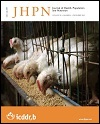Prevalence of Hepatitis B e Antigen in Chronic HBV Carriers in North-central Nigeria
DOI:
https://doi.org/10.3329/jhpn.v30i4.13289Keywords:
HBeAg, HBsAg, Hepatitis B virus, Hepatocellular carcinoma, NigeriaAbstract
Hepatitis B virus (HBV) is an important clinical problem due to its worldwide distribution and potential of adverse sequelae, including hepatocellular carcinoma (HCC). We studied the prevalence of hepatitis B virus e antigen (HBeAg) among individuals determined to be HBV surface antigen-positive (HBsAg+) and analyzed the gender/age category associated with more active HBV infection. A total of 572 HBsAg+ individuals, as determined by a double antibody sandwich ELISA method, participated in the study. They were tested for HbeAg, using a lateral flow chromatographic immunoassay. One hundred and ten individuals were found to be HBeAg-positive giving an overall prevalence of 19.2%. Of these 110 individuals, 20 (18.2%) were females, and 90 (81.8%) were males. Thus, the prevalence of HBeAg appears to be higher in males than in females (p<0.05). Our data also revealed that the prevalence of HBeAg was higher in patients between the age-group of 0-10 years and 11-20 years and appeared to decrease with increase in age. Taken together, our data show that approximately 1/5 of HBV-infected individuals are HBeAg+, suggesting that the virus is actively replicating and infecting liver-cells thereby ensuring an HBV-transmission pool within the Nigerian population. We suggest strengthening of the childhood HBV vaccination programmes, massive intervention activities, and treatment programmes, especially among young people to reverse the possible devastating effect of HBV infection. The success of these efforts will depend on our resolution to make the elimination of HBV infection a top priority on the public-health agenda as we start the second decade of this new century.
DOI: http://dx.doi.org/10.3329/jhpn.v30i4.13289
J HEALTH POPUL NUTR 2012 Dec;30(4):377-382
Downloads
180
198

